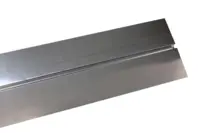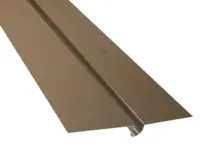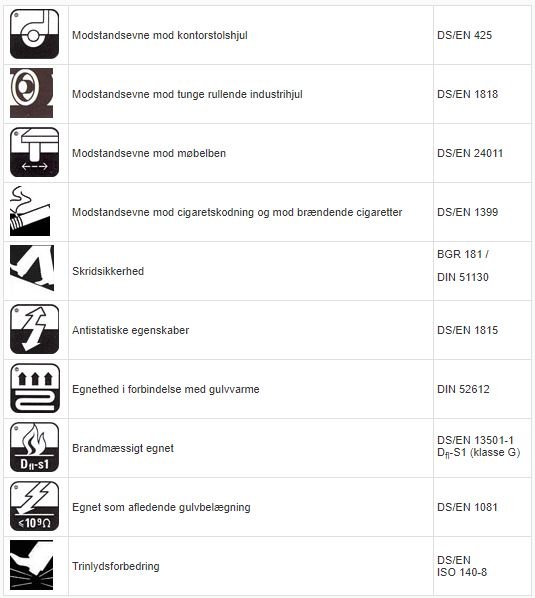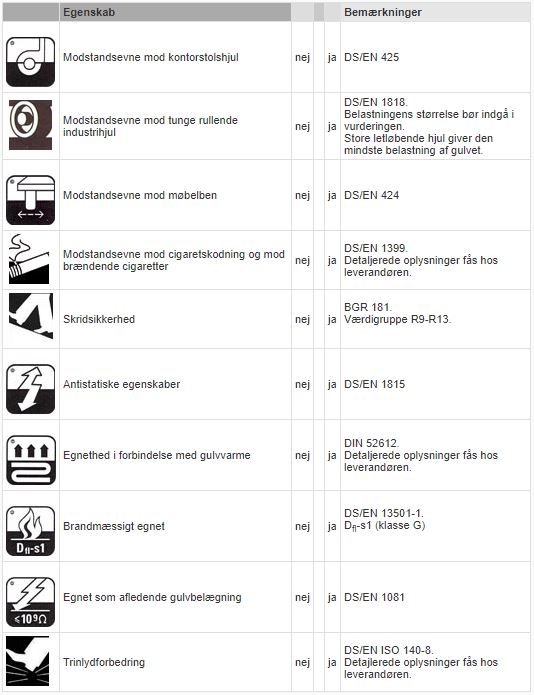- Akustikpaneler
- Afpassede tæpper
- Bambusgulve
- Bordplader & bordben
- Designgulve
- Fliser og klinker
- BeefEater gasgrill
- Gode råd om gulv
- Gulvtæpper
- Gulvvarme
- Græstæpper
- Korkgulve
- Køkken, bad & garderobe
- Laminatgulve
- Linoleumsgulve
- Maling, Væv & Spartel
- Måtter
- Møbler & Boliginteriør
- Nålefilt og messetæpper
- Plejeprodukter
- Restpartier & gode tilbud
- Sildebensparket & Stavparket
- Tæppefliser
- Terrassebrædder
- Tilbehør
- Trægulve
- Vareprøver
- Vinylgulv
- Værktøj
- Øvrige produkter
- Loft- og vægpaneler
- Flotte gulve
- Fyrretræsgulv
- Klikgulve
- Bestilte varer
-
-26%
-
Populær29,00 DKK
-
29,00 DKK pr m2
-
Populær21,00 DKK
-
-59%39,00 DKK pr m295,00 DKKDu sparer: 56,00 DKK pr m2
Linoleum
Alle informationer på denne side er kopieret materiale fra Gulvfakta som er et fagteknisk opslagsmateriale, Kilde: Gulvfakta
https://gulvlageret.dk/linoleums-bordplader-635/https://gulvlageret.dk/linoleums-bordplader-635/Linoleum er et organisk materiale, hvis væsentligste bestanddel er linoleumscement, som består af iltet linolie og harpiks. For at opnå de ønskede egenskaber tilsættes der forskellige hjælpematerialer ved fabrikationen, fx korkmel, træmel, stenmel, kalk og farvepigmenter. Linoleum valses (kalandreres) på et underlag af fibermateriale, fx jutevæv. Indholdet af linoleumscement er mindst 30%, og indholdet af uorganiske fyldstoffer højst 50%. Overfladen er normalt påført en overfladebehandling. Linoleum er et "levende" materiale, hvilket betyder, at hvis der f.eks. kommer en ridse i dit linoleumsgulv, vil de med tiden forsvinde af sig selv.
1.3.1.1 Introduktion
1.3.1.2 Egenskaber
1.3.1.3 Lægning og brug
1.3.1.4 Checkliste 1 og 2
Alle informationer på denne side er kopieret materiale fra Gulvfakta som er et fagteknisk opslagsmateriale, Kilde: Gulvfakta
1.3.1.1 Introduktion
Et linoleumsgulv er et af de gulvbelægninger med flest miljømærker og fremstilles primært i bæredygtigt materialer.
• Linoleum anvendes i tørre rum i skoler, sygehuse, kontorer, butikker, boliger etc. Dette skyldes, at et linoleumsgulv kan holde til væsentlig belastning og at linoleum har en selvreparerende effekt. Linoleum fås dels som homogene gulvbelægninger, hvor hele tykkelsen består af et eller flere lag med samme sammensætning, farve og mønstre gennem hele tykkelsen og dels som heterogene gulvbelægninger med en bagside af skum- eller korkment.
• Linoleum leveres som banevarer i 2 m bredde eller fliser. Tykkelserne for banevarene er 2.0, 2.5, 3.2, 4.0 og 4.5 mm. Fliserne kan være fabriksfremstillede eller udskåret af banevare. Fliser udskåret af banevarer har større tolerancer end fabriksfremstillede fliser. Herudover kan linoleum også leveres som svømmende gulv.
• Linoleum, der anvendes som gulvbelægning skal være CE-mærket. CE-mærkning af elastiske gulvbelægninger er omtalt i afsnittet om CE-mærkning af elastiske gulvbelægninger.
• Linoleum der benyttes som gulvbelægning i flugtveje og andre områder med krav til brand og røgudvikling, skal have dokumentation for at opfylde den europæiske brandklasse Dfl-s1 i henhold til DS/EN 13501-1 (klasse G gulvbelægning).
• Gangkomforten og trinlydsdæmpningen for linoleumsgulve kan forbedres ved brug af eftergivelige underlag, fx korkment. Underlag skal dog altid godkendes af linoleumsleverandøren, og tykkelse må ikke overstige gulvbelægningens tykkelse. En række dessiner leveres fra fabrikken med underlaget pålimet til linoleummets bagside. Denne type af linoler kaldes ofte for "akustik linoleum". Der må påregnes større restindtrykning i linoleummet, når det ligger på et eftergiveligt underlag.
• Linoleum med et højt indhold af groft granuleret kork kaldes korklinoleum. Det er mere trinlyddæmpende og mere varmebehageligt men mindre slidstærkt end almindelig linoleum.
• Linoleum kan leveres som elektrostatisk afledende gulvbelægning til anvendelse i rum med krav til personafladning. Leverandøren kan give detaljerede oplysninger om belægningernes elektriske modstandsevne. Overfladen af linoleum er glat og nem at renholde. Korklinoleum har en mere ru overflade pga. indholdet af grovere korkgranulat.
• Linoleum skal beskyttes mod langvarige fugtpåvirkninger, påvirkning af alkaliske stoffer, som fx visse rengøringsmidler, og opløsningsmidler.
For alle klassificerede typer af linoleum ydes der 5 års slidgaranti i henhold til Gulvbranchens regler for materialegaranti, under forudsætning af at leverandøren har godkendt anvendelsesområdet.
Vi fører et bredst udvalg af linoleumsgulve, herunder brands som Forbo, DLW og Tarkett. Se bl.a. disse linoleumsgulve Forbo Marmoleum Fresco Volcanic Ash, DLW Mamorette Plump Grey eller Tarkett Veneto xf2 Fog linoleumsgulv, der er blandt vores populære gulve.
Foruden linoleumsgulve er vi også specialister inden for linoleums bordplader, der er praktiske og lette at holde.
1.3.1.2 Egenskaber
Linoleum, som er EN-klassificeret, skal opfylde DS/EN 24011 og dermed overholde specifikke krav til:
• Længde, bredde, tykkelse og rethed
• Dimensionsstabilitet ved fugtændringer
• Fleksibilitet og modstandsevne mod indtrykningsmærker
• Farveægthed mod kunstigt lys
• Tykkelse af belægningens underlag
Klassifikation af linoleum sker efter anvendelsesområde med tykkelsen som grundlag for klassifikationen, se checkliste 1. Der skelnes i klassifikationen kun mellem tykkelserne 2.0 og 2.5 mm. Tykkelsen af linoleummet kan for at opfylde særlige brugerønsker vælges op til 4.5 mm afhængigt af den forventede brugsintensitet, dvs. afhængigt af anvendelsesområde og belastning.
De i checkliste 1 viste klasser til beboelse, erhverv og industri kan yderligere underdeles i moderat, normal, høj og meget høj. Udover de egenskaber, der indgår i klassifikationen, vil der ofte være behov for at stille krav til andre egenskaber, afhængigt af den aktuelle anvendelse. Disse egenskaber indgår i Gulvbranchens supplerende egenskaber, som for linoleum omfatter:
Herudover kan der evt. stilles krav i forbindelse med gangbehagelighed og varmebehagelighed.
Udseende
Ny og frisk linoleum kan undertiden fremtræde med en let gultoning af overfladen (gulfilm eller tørrekammmerfilm). Denne toning forsvinder, når linoleummet udsættes for dagslys, hvorefter det vil fremtræde i sin originalfarve. Gulfilm eller tørrekammerfilm må tages i betragtning ved vurdering af kollektionsprøver. Prøver bør derfor lægges i sollys i nogle døgn før endelig farvevurdering.
Krav til udførelsesstedet
Der skal være afsat tid til, at linoleummet kan akklimatiseres. Akklimatiseringen sker ved, at linoleummet opskæres og stilles lodret i løst oprullet form i mindst 24 timer før pålægning. En emballeret rulle vil selv efter længere tids opbevaring i bygningen ikke kunne forventes at være i fugtmæssig ligevægt med omgivelserne. Under og efter limning af linoleum skal temperaturen i luften og undergulvet være 17-25°C og luftfugtigheden 35%-75% RF.
Underlaget skal have samme planhed, som kræves af det færdige gulv, normalt ± 2 mm på et 2 m retholt. Planhed og gulve, herunder krav og målemetoder, er beskrevet i Valg af gulv i afsnittet Planhed og gulve. Skal linoleum udlægges direkte på støbte dæk, må betonens porefugt (restbyggefugt) højst være 85% RF. Fugt og gulve, herunder krav og målemetoder, er ligeledes beskrevet i afsnittet Teknik og kvalitet. Der må ikke være kraftig træk eller kraftigt solindfald under lægningen af gulvet. Linoleumsruller opbevares stående. Linoleum skal lægges på et sugende underlag for at sikre, at limen hæfter godt til underlaget. Såfremt der ikke er tilstrækkelig sugeevne, fx på underlag af asfalt eller epoxy, skal der påføres et mindst 2 mm tykt lag egnet spartelmasse.
1.3.1.3 Lægning og brug
Forhold i forbindelse med lægning og brug
Linoleum svinder og udvider sig i forbindelse med fugtoptagelse og fugtafgivelse, fx ved fugt fra klæbning eller ved ændringer i luftfugtighed. Det må derfor forventes, at tilskæring til tilstødende konstruktioner eller sammenskæringer i stødte samlinger i tørre perioder kan åbne sig en smule. Tæt tilskæring til lodrette flader er ikke mulig, derfor vil det være nødvendigt at montere lister, hvis der ikke ønskes en synlig fuge langs gulvet. Linoleum svinder i banernes længderetning, og udvider sig på tværs af baneretningen. Korrekt friskæring i banesamlinger er derfor meget vigtig, da limfugen i første del af limens hærdefase ikke vil kunne fastholde belægningen til underlaget, hvis der sker sammenpresning i samlingen. Leverandørens anvisninger om udførelse af til- og sammenskæringer skal følges.
Linoleum kan enten lægges med stødte samlinger, hvilket fx ofte anvendes ved mønsterlægning, eller ved at fugerne forsegles med en smeltetråd, som nedsmeltes i den fugefræste samling mellem banerne. Ensfarvede belægninger er brugsmæssigt krævende, fordi de stiller store krav til rengøring for at opretholde samme synsindtryk som for marmorerede linoleumsbelægninger. Desuden vil pladesamlinger i underlaget og forsegling med smeltetråd fremtræde mere synlig end ved marmorerede linoleumsbelægninger. Principperne for banedisponering bør aftales mellem entreprenøren og bygherre, under hensynstagen til de rullelængder, hvori varen kan leveres. Er intet andet aftalt, bør baner altid føres ubrudt ind i dørhuller og vinduesnicher. Ved store rum (> 60 m2) bør banerne montres i fortløbende nummer rækkefølge. Herved kan der opstå et behov for endesamlinger. Herudover kan hængefolder give et behov for endesamlinger. Korrekt udførte endesamlinger har en holdbarhed som langsgående samlinger.
Trådfugning
Trådfugning med smeltetråd må ikke foretages, før limen er hærdet. Efter fugningen skal tråden afskæres i niveau med overfladen af banerne, så rengøringsvand og snavs ikke samler sig i og omkring samlingen. Leverandørens anvisning om trådfugning skal følges.
Elektrostatisk afledende gulve
Linoleum er egnet som afledende gulvbelægning og kan anvendes i lokaler, hvor der er behov for en bortledning af elektriske opladninger.
Afledende linoleum har en speciel sammensætning og lægges i ledende lim. Desuden skal gulvet yderligere være forbundet til jord gennem kobbertråd i henhold til leverandørens anvisninger. Det skal aftales, hvor gulventreprenøren skal føre kobbertråden op ad væggen.
Udførelse af elektrostatisk afledende linoleumsgulve skal foretages i samråd med belægningsleverandøren. Jording skal foretages af autoriseret elinstallatør.
Statisk afledende og statisk ledende elastiske gulvbelægninger - begreber, krav m.m. - er nærmere beskrevet i Valg af gulv i afsnittet Elektrostatisk opladning.
Rengøring
De fremtidige brugere skal oplyses om korrekt rengøring, da forkert rengøring kan medføre skader på overfladen og generende lugt ved gulvvask. Leverandørens anvisning om rengøring og vedligeholdelse af linoleumsgulve skal udleveres til brugeren. Til daglig rengøring anvendes tør- eller fugtmopning eller støvsugning. Gulvet vaskes efter behov.
I områder, hvor det er nødvendigt med vådrengøring i større omfang, bør banesamlinger tætnes (trådfuges) med en smeltetråd. Rengøring af linoleumsgulve er omtalt i afsnittet Rengøring af elastiske gulvbelægninger.
Byggerengøring - rengøring af linoleumsgulv før ibrugtagning
Linoleum er fra fabrikkens side behandlet med en beskyttende overfladebehandling, der beskytter gulvet i byggeperioden, letter den fremtidige rengøring og minimerer rengøringsomkostningerne. Overfladbehandlingen er en integreret del af belægningen og skal derfor kun fjernes, hvis der er forhold, som gør det påkrævet. Er belægningen blevet tilsmudset/ridset i byggeperioden skal den opskures med en egnet skurerondel tilsat rengøringsmiddel. Herefter vaskes belægningen med et vaske-/plejemiddel. Leverandørens anvisninger skal følges.
1.3.1.4 Checkliste 1 og 2
Egenskaber som indgår i EN-klassifikationen af linoleumsgulve.
Checkliste 1. Klassifikation af linoleum til brug i henholdsvis boliger, erhverv og industri sker på grundlag af tykkelsen. Klasserne kan yderligere underdeles i moderat, normal, høj (og meget høj). Øvrige egenskaber overholder for EN-klassificerede produkter de markerede værdier. De angivne værdier er minimumsværdier.
Checkliste 2. Supplerende egenskaber, som der kan være behov for at stille krav til, fx på grund af særlige påvirkninger af gulvet ved den aktuelle brug.

















